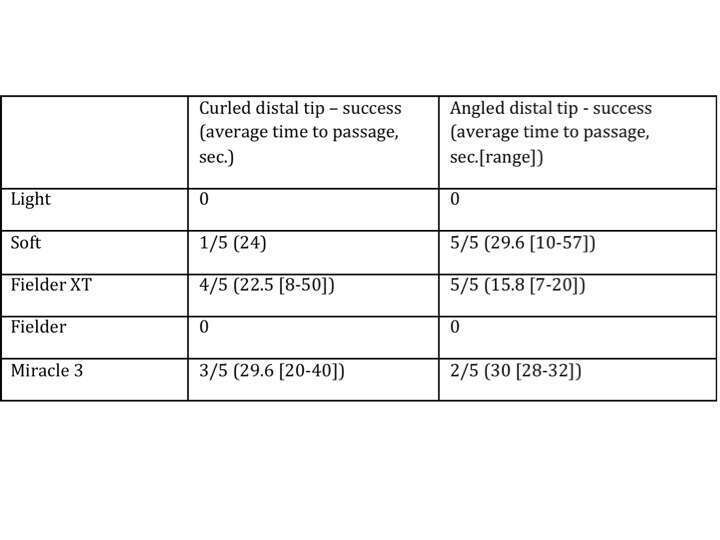Background:
The MGuard stent is a bare-metal stent with an outer Poly-Ethylene-Terephthalate (PET) fiber knitted sleeve mesh aiming to trap potential embolic debris. Our aim was to assess the optimal wire type and distal wire shape for passage from within an MGuard stent across a bifurcation where a significant side branch has been covered.
Methods:
MGuard stents (3.5mm) were deployed in a transparent silicon bifurcation model (3.2mm inner lumens of all branches) with a configuration of a 60° sidebranch takeoff. Wire access and manipulation was through a 100cm guide catheter. Five Asahi wire types were used: Light, Soft, Fielder, Fielder XT and Miracle 3 each with two distal shapes: curled, double angled. For each set of conditions five 60-second attempts were made to cross the stent into the sidebranch under full vision with microscopy.
Results:
 Wire passage success was dependent upon 3 wire tip features: weight, caliber and shape. Reduced tip caliber improved the passing success irrespective of the other features. Increasing weight appeared to increase the success, as did the double angle. The Fielder XT passage through the sleeve was not associated with mesh distortion as occurred with heavier wires, particularly the Miracle 3. Balloon dilation through the sleeve resulted in shifting of the mesh away from the sidebranch ostium with evidence of mesh disruption on occasion by a combination of fiber shift and tearing with partially detached fiber fragments visible. No significant recoil of the mesh was noted.
Wire passage success was dependent upon 3 wire tip features: weight, caliber and shape. Reduced tip caliber improved the passing success irrespective of the other features. Increasing weight appeared to increase the success, as did the double angle. The Fielder XT passage through the sleeve was not associated with mesh distortion as occurred with heavier wires, particularly the Miracle 3. Balloon dilation through the sleeve resulted in shifting of the mesh away from the sidebranch ostium with evidence of mesh disruption on occasion by a combination of fiber shift and tearing with partially detached fiber fragments visible. No significant recoil of the mesh was noted.
Conclusions:
In this dry bench model, FielderXT was the most useful wire for crossing the mesh probably due to its smaller caliber tip. A double angled tip increased passage success. Heavier wires can also be used but require more force and appear to be more disruptive to the mesh. Balloon inflation of the sidebranch results in a permanently increased mesh aperture potentially improving sidebranch flow.

